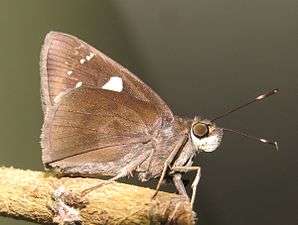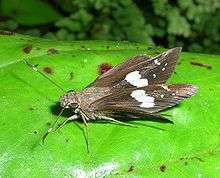Notocrypta curvifascia
Notocrypta curvifascia, the restricted demon,[1] is a butterfly belonging to the family Hesperiidae. N. curvifascia is commonly found in many regions of temperate and tropical East Asia, Indonesia, and the Indian subcontinent.[1][2]
| Restricted demon | |
|---|---|
 | |
| From Wayanad, Kerala, India | |
| Scientific classification | |
| Kingdom: | |
| Phylum: | |
| Class: | |
| Order: | |
| Family: | |
| Genus: | |
| Species: | N. curvifascia |
| Binomial name | |
| Notocrypta curvifascia (Felder & Felder, 1862) | |
Among butterflies, it is relatively small, at approximately 4 cm long (adult). Its wings are dark brown to black, with a white eyespot near the trailing end.
Host plants

The larval host plants include members of the Zingiberaceae and Musaceae families such as Alpinia japonica, Alpinia zerumbet, Curcuma decipiens, Costus speciosus,[3] Curcuma longa, Globba marantina, Musa acuminata × balbisiana, Zingiber casumunar, Zingiber odoriferum, Zingiber officinale.[4] Other plants include Hedychium species[3] and Zingiber zerumbet.[5]
References
- R.K., Varshney; Smetacek, Peter (2015). A Synoptic Catalogue of the Butterflies of India. New Delhi: Butterfly Research Centre, Bhimtal & Indinov Publishing, New Delhi. pp. 48–49. doi:10.13140/RG.2.1.3966.2164. ISBN 978-81-929826-4-9.
- W. H., Evans (1949). A Catalogue of the Hesperiidae from Europe, Asia, and Australia in the British Museum. London: British Museum (Natural History). Department of Entomology. p. 286.
- Kunte, K. 2006. Additions to the known larval host plants of Indian butterflies. J. Bombay Nat. Hist. Soc. 103(1):119-121
- Gaden S. Robinson, Phillip R. Ackery, Ian J. Kitching, George W. Beccaloni AND Luis M. Hernández. HOSTS - a Database of the World's Lepidopteran Hostplants. Accessed March 2007
- Kalesh, S & S K Prakash (2007). "Additions of the larval host plants of butterflies of the Western Ghats, Kerala, Southern India (Rhopalocera, Lepidoptera): Part 1". J. Bombay Nat. Hist. Soc. 104 (2): 235–238.